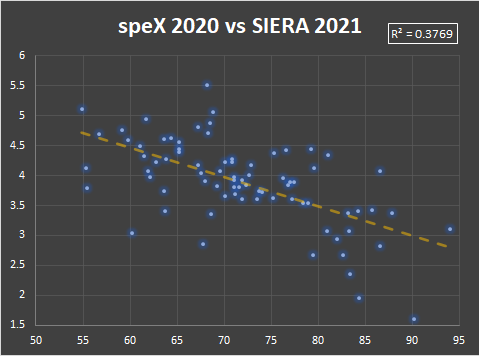Before starting the season, we unveiled the Simple Pitching Estimation indeX, speX.
I recommend checking that article for a more in-depth look, but here is a summary: after testing their individual usefulness, we combined a handful of simple stats, weighting, combining, and scaling them appropriately to create an index that tries to predict a pitcher’s future performances.
We also did some statistical tests to corroborate the results against historical data, with very good results; then, we calculated the index before the start of this season and speX highlighted Tyler Glasnow (sadly injured now), Corbin Burnes, Kevin Gausman (again), among others.
In that article, you can check the leaderboards entering the 2021 season.
That was then, but how has speX fared? Rather nicely, actually.
I will use my The Great Fantasy Baseball Invitational (TGFBI) team as an example of how I used speX, first at the draft, and during the first months of the season.
The Draft
TGFBI’s leagues are typical 15 teams, standard 5×5 Roto, FAAB leagues, with a 30-player roster of which nine are pitchers and the rest distributed among two catchers, five outfielders, 1B, 2B, 3B, SS, CI, MI, a utility hitter, and seven bench slots.
I got the 9th draft slot and I decided I’d go hitters as much as possible in the beginning and would try to get big upside pitchers, using speX, in the following rounds.
So, for my first two picks, I got Mike Trout and Bryce Harper, and I was a very happy camper, without knowing what the Injury Gods had in store for them/me.
Then, my third pick was Whit Merrifield, who has probably been my best offensive player the whole season, for better or worse.
Before continuing with the picks, let’s look at the end of 2020 speX leaderboard:
I’ve highlighted in dark yellow the pitchers drafted before my fourth-round pick turn. Most of the top-15 guys by the index were already taken, but I was in a great situation, as those four were available in the same tier as numbers 3, 4, and 5.
Dinelson Lamet was out of the question because of injury and Joe Musgrove was not very appealing at that draft pick (according to ADP), leaving me with the options of Burnes and Gausman.
Burnes, then, was an easy choice as my SP1, something I would repeat frequently in other drafts as he typically went at around pick number 57-60, and I took him here in round four, pick 52 overall. Can’t complain about this.
My next pitcher was closer Edwin Diaz as a small, closers run went on (Josh Hader, Aroldis Chapman, and Liam Hendricks were gone, now). Then, I kept drafting hitters until my eighth-round pick.
At that round, with my 112th pick, I got Kevin Gausman. It was a semi-reach as his ADP at the moment was 135, but I did not want to run any risk of potentially losing him. Besides, I’ve been high on Gausman for a while, and I was happy to push his ADP.
For round nine, I was out of SPs from the top 15 2020 speX Leaderboard, so I checked the next 15:
After discarding a trio of relievers, I was left with some interesting options which basically had almost the same speX of 77 to 80 units; I focused on two of them, Tyler Mahle and Nathan Eovaldi, basing it also on their Spring Training performances and peripherals. I took Mahle in round nine at pick 129; after him, I got a mix of five hitters and relievers, and then Eovaldi at 219 in round 15.
I completed my SP staff with Josh Lindblom (Round 20), Tarik Skubal (Round 23), Griffin Canning (Round 24), and Trevor Rogers (Round 25), the last SP I drafted.
All the SPs were taken because, from the available pitchers, they had the best speX number. The only exception was Trevor Rogers, for which I did not have enough innings pitched to calculate his 2020 speX, but I relied on what a highly respected prospects analyst like Ray Butler was saying about him.
In retrospect, as the core of this staff is still in my team (Burnes, Gausman, Mahle, Eovaldi, and Rogers) and I haven’t made too many changes (just replacing Lindblom). Currently, I have the second-best pitching points in the league.
First Two Months of the 2021 Season
I must admit, I got a little anxious and parted ways with Skubal and Canning more quickly than I should have. Skubal is having a really cool second wind and has turned things around from his early-season struggle. What’s done, is done.
Using the guidance of the 2021 speX Leaderboard, I was able to get three very worthy replacements in Alex Cobb, Luis Garcia, and Logan Webb (currently in the IL, unfortunately).
My complete current SP staff looks like this:
This pitching staff has provided a very high return on investment, especially considering the, mostly, late ADPs or inexpensive FAAB they had. Unfortunately, the balance picks used on hitting have not met their potential, with injuries really hurting the offensive production.
Nevertheless, I’m still fighting for third place with the amazing Brian Entrekin (KC Bubba), in second place is Mr. #Bloomboards himself, Ryan Bloomfield, and the league leader, with a ridiculous 30-point advantage, Draft Champions Podcast’s own, Zack Waxman.
Still, the season is very long and anything can happen, but I’m pretty confident my pitching will hold, it’s just a matter of the hitting part to put it together.
In Numbers
After looking at the practical example, above, we can also do a correlation test for statistical probing. For that, using the same methodology we used for developing speX in the first place (as explained in the primer article) I correlated 2020 speX with this 2021 season’s SIERA, for pitchers with a minimum of 40 IP in both years (n=78).
The following graphic shows the relationship:

With a Coefficient of Determination, R2, of 0.3769, this means that speX 2020 could explain a little more than 63% of the 2021 SIERA for that group of pitchers, which for baseball is actually very good and very close to the 67% we got in the previous article, which benefitted from greater IP figures.
After all these points, and having both a practical example and a statistical validation, we can conclude that speX continues to be a good tool for analyzing MLB pitchers and getting a good estimate of what we can expect in the coming weeks/months.
I’m keeping a three-times-a-week updated spreadsheet with the latest speX in this link, which I hope provides useful supplementary information after you’ve checked our Players Pages, articles and lists, here at Pitcher List.
In the speX Leaderboard you will find that Webb still ranks 38 at the moment of writing this and is available in approximately half the leagues; I know he’s hurt, but he has resumed a throwing program and could be ready in 2-3 weeks.
Also, although he only has 15 IP, Luis Patino is an interesting speculative add to monitor the following weeks, as he is sporting a 77 speX rating, and is widely available in leagues different to dynasty.
Remember, speX is not a catch-it-all statistic; it has its limitations and, as with everything in life, it is up to us to understand those limitations but, it looks like it can be of great help.
Photo by Cody Glenn/Icon Sportswire | Feature Image by Justin Redler (@reldernitsuj on Twitter)

